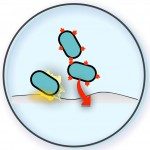Lien vers Pubmed [PMID] – 21344461
Bioessays 2011 Apr;33(4):300-11
Proteinaceous stalks produced by Gram-negative bacteria are often used to adhere to environmental surfaces. Among them, chaperone-usher (CU) fimbriae adhesins, related to prototypical type 1 fimbriae, interact in highly specific ways with different ligands at different stages of bacterial infection or surface colonisation. Recent analyses revealed a large number of potential and often “cryptic” CU fimbriae homologues in the genome of commensal and pathogenic Escherichia coli and closely related bacteria. We propose that CU fimbriae form a yet unexplored arsenal of lectins, carbohydrate-binding proteins involved in various aspects of bacterial surface adhesion and tissue tropism. Combined efforts of molecular and structural biologists will be required to unravel the biological contribution of the bacterial lectome, however, current progress has already opened up new perspectives in the design of novel anti-infective strategies.


